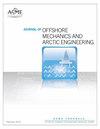Numerical Investigations on Suspended Power Cable Configurations for Floating Offshore Wind Turbines in Deep Water Powering an FPSO
IF 1.3
4区 工程技术
Q3 ENGINEERING, MECHANICAL
Journal of Offshore Mechanics and Arctic Engineering-Transactions of the Asme
Pub Date : 2023-03-16
DOI:10.1115/1.4057006
引用次数: 2
Abstract
Abstract Floating offshore wind turbines (FOWTs) are an opportunity for floating production storage and offloading units (FPSOs) to reduce emissions. To avoid long connecting power cables with long transmission distances between a FOWT and an FPSO, the novel concept of a suspended power cable in a large water depth of 1000 m is investigated in this study. The power cable is kept floating between the sea surface and the seabed without touching either of them. A catenary configuration and two configurations with subsea buoys attached at different locations along the cable are investigated. The OC3-Hywind 5 MW reference FOWT is set up with a deepwater mooring system, and a spread-moored FPSO is modeled with characteristics similar to existing FPSOs. Steady-state and dynamic simulations are carried out in the numerical software OrcaFlex. The different configurations are first evaluated in steady-state analyses. The largest tensions are observed for the catenary configuration, whereas it shows the lowest horizontal cable excursions. Buoys attached along the center section of the cable lift it into regions with strong currents. This results in a large horizontal excursion of the cable and large tensions. The suspended configuration with buoys attached evenly over the cable results in significantly lower tensions than the other two configurations. It is studied further with dynamic analyses. The tensions at the floater hang-offs increase by a maximum of 24% compared to steady-state results indicating that dynamic analysis is crucial for the design of suspended cable configurations.浮式海上风电机组深水动力系统悬索结构数值研究
浮式海上风力涡轮机(FOWTs)是浮式生产储存和卸载装置(fpso)减少排放的一个机会。为了避免FOWT和FPSO之间的长连接电力电缆和长距离传输,本研究探讨了在1000 m大水深中悬挂电力电缆的新概念。电力电缆保持漂浮在海面和海底之间,而不接触两者。研究了悬链线配置和海底浮标在电缆不同位置连接的两种配置。OC3-Hywind 5兆瓦参考FOWT采用深水系泊系统,扩展系泊FPSO的建模特征与现有FPSO相似。在数值软件OrcaFlex中进行了稳态和动态仿真。不同的结构首先在稳态分析中进行评估。在悬链线结构中观察到最大的张力,而它显示出最低的水平缆索偏移。沿电缆中心部分安装的浮标将其提升到有强电流的区域。这导致索的水平偏移和大张力。与其他两种配置相比,在电缆上均匀附着浮标的悬挂配置显著降低了张力。对其进行了进一步的动态分析。与稳态结果相比,浮子悬挂处的张力最大增加了24%,这表明动态分析对于悬索配置的设计至关重要。
本文章由计算机程序翻译,如有差异,请以英文原文为准。
求助全文
约1分钟内获得全文
求助全文
来源期刊
CiteScore
4.20
自引率
6.20%
发文量
63
审稿时长
6-12 weeks
期刊介绍:
The Journal of Offshore Mechanics and Arctic Engineering is an international resource for original peer-reviewed research that advances the state of knowledge on all aspects of analysis, design, and technology development in ocean, offshore, arctic, and related fields. Its main goals are to provide a forum for timely and in-depth exchanges of scientific and technical information among researchers and engineers. It emphasizes fundamental research and development studies as well as review articles that offer either retrospective perspectives on well-established topics or exposures to innovative or novel developments. Case histories are not encouraged. The journal also documents significant developments in related fields and major accomplishments of renowned scientists by programming themed issues to record such events.
Scope: Offshore Mechanics, Drilling Technology, Fixed and Floating Production Systems; Ocean Engineering, Hydrodynamics, and Ship Motions; Ocean Climate Statistics, Storms, Extremes, and Hurricanes; Structural Mechanics; Safety, Reliability, Risk Assessment, and Uncertainty Quantification; Riser Mechanics, Cable and Mooring Dynamics, Pipeline and Subsea Technology; Materials Engineering, Fatigue, Fracture, Welding Technology, Non-destructive Testing, Inspection Technologies, Corrosion Protection and Control; Fluid-structure Interaction, Computational Fluid Dynamics, Flow and Vortex-Induced Vibrations; Marine and Offshore Geotechnics, Soil Mechanics, Soil-pipeline Interaction; Ocean Renewable Energy; Ocean Space Utilization and Aquaculture Engineering; Petroleum Technology; Polar and Arctic Science and Technology, Ice Mechanics, Arctic Drilling and Exploration, Arctic Structures, Ice-structure and Ship Interaction, Permafrost Engineering, Arctic and Thermal Design.

 求助内容:
求助内容: 应助结果提醒方式:
应助结果提醒方式:


